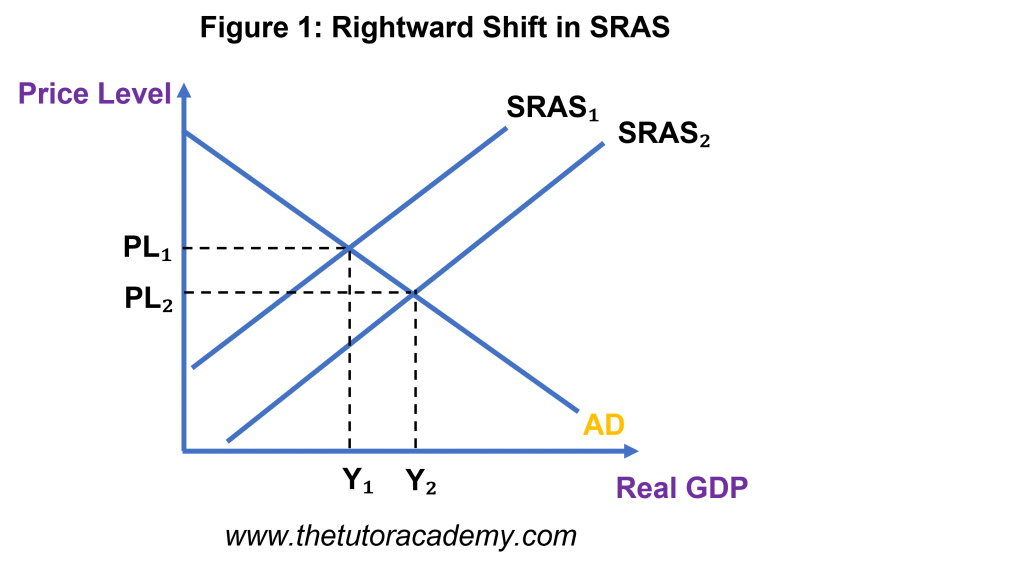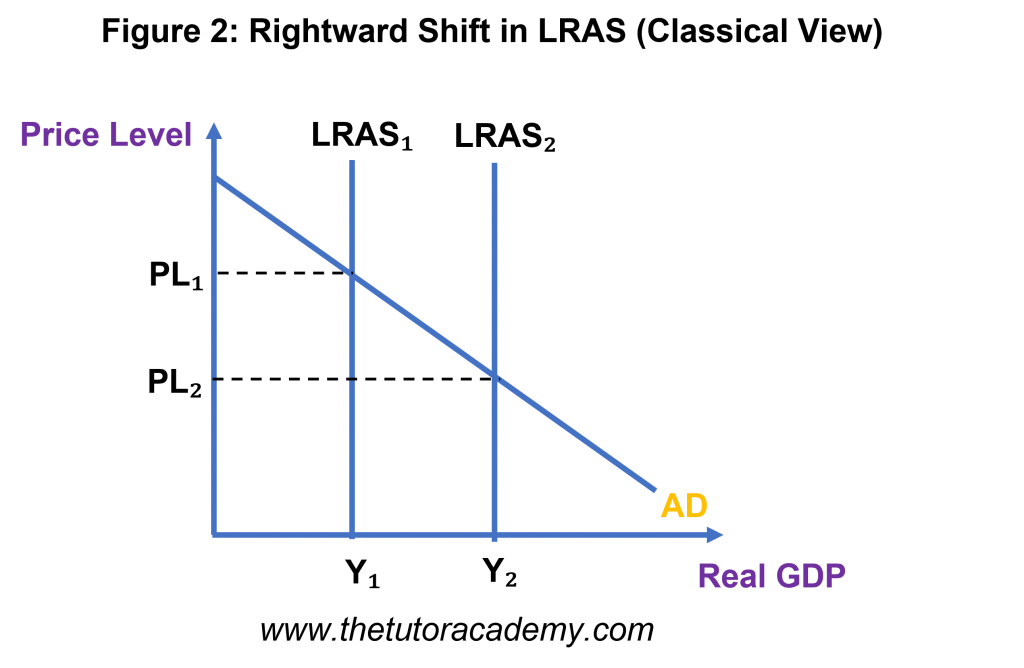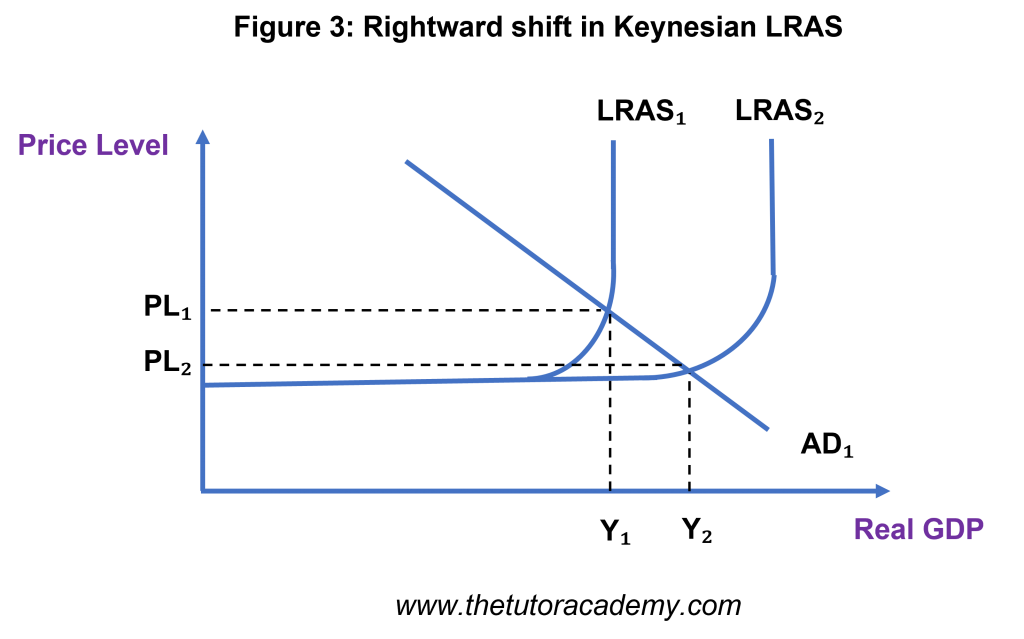Supply Side Policies
Supply Side Policies
Level: AS Levels, A Level, GCSE – Exam Boards: Edexcel, AQA, OCR, WJEC, IB, Eduqas – Economics Revision Notes
Supply-Side Policies
Supply-side policies aim to shift the aggregate supply (AS) curve to the right. They are controlled by the government and aim to increase the productive potential of a country.
There are a variety of supply-side policies that are used within an economy. They can be split into short-run (SRAS) and long-run (LRAS) supply-side policies.
Supply Side improvements occur in the private sector when there are improvements in productivity, innovation and investment
Market Based Policies
- These are policies in place which aim to remove anything acting as a barrier towards the efficient operation of the free market
- Examples of these ‘barrier’s include: higher prices, anything which reduces the willingness for a worker to take a job, or inefficient production
Interventionist Policies
- These are policies which aim to correct market failure with the use of government intervention
- Economists who support Interventionist Policies believe the free market does not operate efficiently and hence believe there is a need for the government to intervene
Short-run supply-side policies
There is a shift in the short-run aggregate supply curve if there is a change in the cost of production.
Causes of SRAS Shifts
- A decrease in corporation Tax – firms will be able to retain a larger amount of profit if they are taxed less; they can pass this greater income to the workers
- A decrease in the price of oil or other commodities
- A decrease in the national minimum wage (NMW) – if the Minimum Wage is too high, the demand for labour may drop as firms cannot afford to hire as many workers, increasing unemployment
- Government providing subsidies – this can be used on public services such as healthcare, schools or infrastructure
- A reduction in tariffs and quotas
- A decrease in Welfare Benefits – may prevent the Poverty Trap from arising as it will increase the opportunity cost of people being unemployed, encouraging them to get a job
Long-run supply-side policies
Causes of LRAS Shifts
There is a shift, in the long run, aggregate supply curve if there is an increase in the quality, quantity or efficiency of a factor of production (Land, Labour, Capital and Enterprise).
- Increase in education and training – this will create a more educated and skilled workforce, increasing the chance of workers securing a job
- Labour market changes e.g. migration – this will improve the quality of the workforce and hence the levels of employment
- Improved infrastructure – the provides better quality public services for people to use and consume
- Increase in healthcare services
- Introduction of new technology or capital – production becomes more efficient as less resources are needed to produce the same amount of goods / services
- Increased innovation or spending on R&D – this allows for the investment into new technology and business models, encouraging more a efficient production of goods / services
Advantages of Supply Side Policies
Lower Inflation
A rightward shift in the AS Curve causes less inflationary pressure. This could be due to increased efficiency and productivity gains produced in the labour markets or a lower National Minimum Wage
e.g. lower prices may arise due to the efficiency caused by technology
Lower Unemployment
The positive effect on labour productivity & competitiveness creates job opportunities and economic growth due to a reduction in structural, frictional and real wage unemployment
Improved Balance of Payments
Increased competitiveness will allow a firm to export more, encouraging a better Balance of Payments
Less Conflicts caused
Supply side policies are less likely to create conflicts between the macroeconomic objectives
Disadvantages of Supply Side Policies
Time Lags
Can take a while for the policies to come into play and have an affect
For e.g. improving the quality of human capital through training and education will take time to produce results
High Costs
Supply side policies usually cost a lot to initiate
for e.g. the cost to implement training courses to improve human capital is costly, especially with inflation and high interest rates
Reduction of Power
Some supply side policies may suffer strong resistance, reducing the power of several interest groups
For e.g. in product markets, the competition policy may cause profits to suffer
Distribution of Income
An increase in aggregate supply causes economic growth which widens the distribution of income between the rich and poor.
Quick Fire Quiz – Knowledge Check
1. Define ‘Supply-Side Policy’ (2 marks)
2. Distinguish between a ‘Short Run Supply Side Policy’ and a ‘Long Run Supply Side Policy’ (4 marks)
3. Explain the causes of a SRAS shift (6 marks)
4. Explain the causes of a LRAS shift (6 marks)
5. Identify and explain ten Supply Side Policies (20 marks)
6. Identify and explain three problems with Supply Side Policies (6 marks)
7. Identify and explain four advantages of Supply Side Policies (8 marks)
8. Identify and explain four disadvantages of Supply Side Policies (8 marks)
Next Revision Topics
A Level Economics Past Papers



